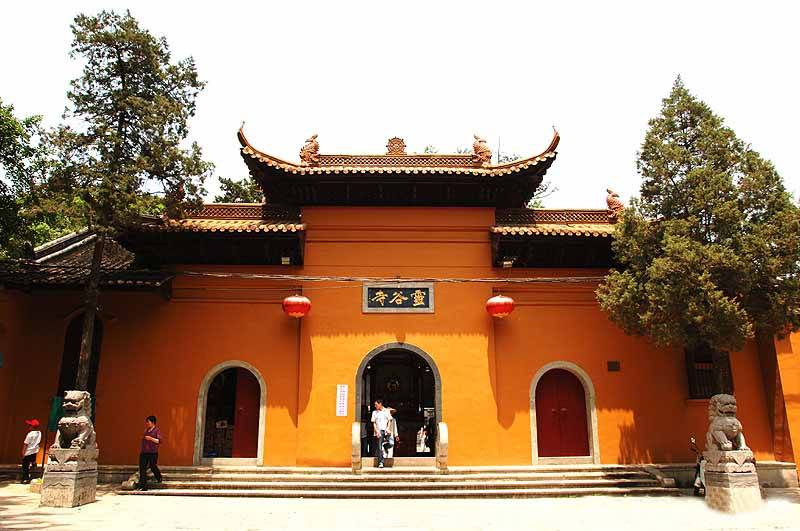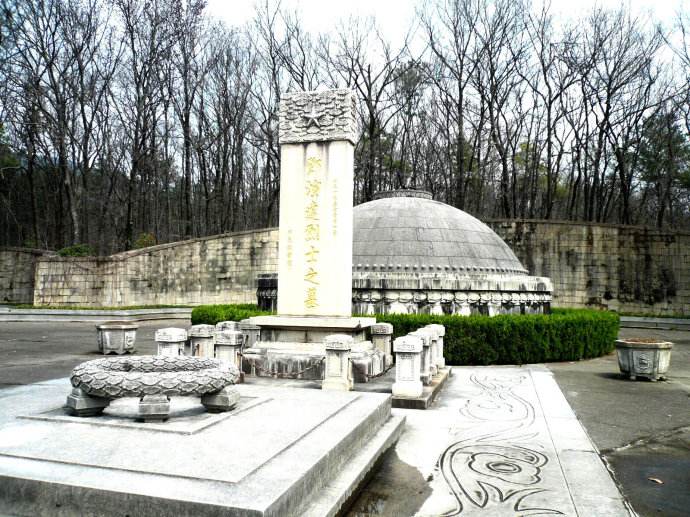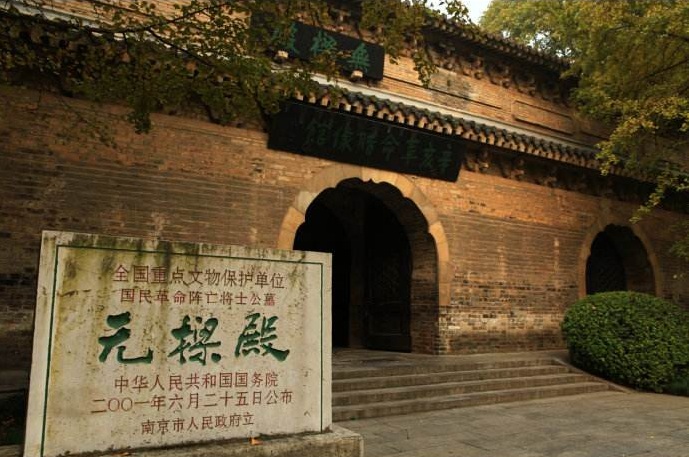24 Hours Hotline: +86 137-3541-1378
Email:suzhou@tripstoshanghai.com
24 Hours Hotline: +86 137-3541-1378
Email:suzhou@tripstoshanghai.com

Linggu Temple, Nanjing Attractions
Breif Introduction
Linggu Temple is a Buddhist temple in Nanjing. It used to lie at the northeast foot of Mount Zhongshan, ie. where Ming Xiaoling Mausoleum now lactes, since since Emperor Zhu Yuanzhang chose the place to be his mausoleum and then the temple was moved to the present place. The temple was named by Emperor Zhu Yuanzhang himself.
Linggu Temple is famous in Chinese history, it was described as "the best Buddhist temple in the world". It is said that in the Ming Dynasty, Linggu Temple flourished. Crowds filled the place to burn joss sticks. It is said that it could hold 1,000 monks at that time. The environment here is very pleasant. The Linggu Temple is surrounded by aged dark green trees and a large park, . The sweet fragrance of flowers pervades, and the sound of the bell is melodious. The forest and springs around add vitality and wild pleasure to the temple.

Linggu Temple has the history of over 1,500 years. Originally constructed in 515 CE, the temple was moved here during the early days of the Ming Dynasty so Emperor Zhu Yuanzhang's tomb could receive the good fengshui of the temple's setting. Wuliang (Beamless) Hall, made without a single piece of wood or a nail, was chosen in 1931 to be the shrine to the over 30,000 soldiers who died in the Northern Expedition War (1926-1928). The Monk Xuanzang, immortalized in Journey to the West for crossing the Himalayas to bring back Buddhist scriptures to the Tang Court, is also memorialized here. Linggu Pagoda sits nearby the temple.
History
The temple was first built in 515 during the Liang dynasty (502-557). It used to lie at the northeast foot of the Purple Mountain, i.e. where the Ming Xiaoling Mausoleum is located, since the Hongwu Emperor of the Ming dynasty (1368–1644) chose the place to be his mausoleum and then the temple was moved to the present place. The temple was named by the Hongwu Emperor himself. It used to be large and covered an area of over 300,000 square metres. Later it was destroyed in warfare during the reign of the Xianfeng Emperor in the Qing dynasty (1644–1911) and rebuilt during the reign of the Tongzhi Emperor. In the temple, except for buddhas and bodhisattvas, Xuanzang and his relics were enshrined and worshipped.

What to see in Linggu Temple
Wuliang Hall
Wuliang Hall is 22 meters high and 53.8 meters wide. It was constructed in 1381, The hall enjoys high reputation for its special architectural techniques. The structure was built with bricks from the bottom to the top entirely, without a piece of wood or a single nail. Thus it was called Wuliang Hall, since Wuliang means beamless. It happens that the hall originally enshrined Amitayus (Buddha of Infinite Life) whose Chinese name pronounces the same with Wuliang.
Later in 1928, the hall was turned into the memorial hall of soldiers who lost their lives in the War of Northern Expedition (1926–1927). More than 30,000 soldiers were enshrined. Linggu Pagoda was built in 1929 as a sign of remembrance for those soldiers. The 9 stories pagoda stands 60.5 metres high. Speeches made by Dr. Sun Yat-Sen and epigraphs of Chiang Kai-Shek were inscribed on the tower.

Linggu Pagoda
Linggu Pagoda is part of the Linggu Temple Scenic Area in Zhongshan Mountian National Park. This is a spacious temple complex with a few attractions, namely this 7-tiered pagoda but also the Linggu Temple and The Tomb og Tai Yankai. The pagoda itself might be enough to draw you here anyway, but nevertheless the combination of surrounding sites makes for a very pleasant and mostly peaceful trip outside of downtown Nanjing.
Linggu Pagoda is not connected with the temple, but was designed by American architect Henry K Murphy and built between 1930 and 1932 as a sign of remembrance for the soldiers. The nine-story-tall pagoda stands 60.5 metres high. Speeches made by Sun Yat-sen and epigraphs of Chiang Kai-shek were inscribed on the tower.

In the temple, there is also a Three Superb Tablet, on which a painting of Baozhi painted by Wu Daozi, a famous painter; a memorial poem written by Li Bai, a Tang dynasty poet; calligraphy written by Yan Zhenqing, a well-known Tang dynasty calligrapher, is inscribed. Since the three were all masters in their own field in the Tang dynasty, the tablet was considered Three Superb Tablet. Unfortunately, the original tablet was broken in warfare, the present one is a duplicate made during the reign of the Qianlong Emperor of the Qing dynasty.
Travel Guide
Admission Fee: CNY 32
Opening Hours: 8:00-17:30
Time for Visit: 2-3 hours
Best Season for Travel: Spring & Autumn
Address: Linggusi Road, Zijin Shan, Nanjing
Tel: +86 25 8443 7786
+86 25 8443 7186
How to get to Linggu Temple
Bus route: take bus No 202 and get off Linggusi (Linggu Temple) stop
Metro route: take Metro line 2 and get off Zhonglingjie and get out from exit 1 and you will reach to Linggu Temple
Duration:10+ Hours
Attractions(Cities):Humble Administrators Garden, Tiger Hill, Hanshan Temple, Pingjiang Road
Tour Style:Embark on the ultimate Suzhou day trip from Shanghai, where you’ll explore the city’s most iconic highlights with a private guide. Discover the beauty of the Humble Administrator’s Garden, a UNESCO-listed masterpiece of classical Chinese landscaping, before heading to Tiger Hill, home to the leaning Yunyan Pagoda and centuries-old legends. Visit the tranquil Hanshan Temple, famous for its ancient bell chimes, and end your journey with a stroll along Pingjiang Road, a charming old street lined with traditional houses, boutique shops, and teahouses. With seamless private transportation and expert guidance, this journey offers an immersive cultural experience in the “Venice of the East.”
Duration:10+Hours
Attractions(Cities):Lingering Garden, Panmen Gate, Hanshan Temple, Shantang Street
Tour Style:A Shanghai to Suzhou day trip offers a perfect blend of history, culture, and scenic beauty, all within easy reach of Shanghai. Begin your journey with a visit to the Lingering Garden, a UNESCO World Heritage site renowned for its classical Chinese landscaping and tranquil atmosphere. Next, explore the iconic Panmen Gate, an ancient city gate that provides a glimpse into Suzhou's rich history and impressive architecture. Continue to the peaceful Hanshan Temple, famous for its ancient bell chimes and historical significance. Finally, stroll along Shantang Street, a charming waterway street lined with traditional buildings, shops, and teahouses. This day trip promises a wonderful exploration of Suzhou’s most famous landmarks.
Duration:6-8 Hours
Attractions(Cities):Humble Administrators Garden, Tiger Hill, Hanshan Temple, Shantang Street
Tour Style:Embark on the ultimate Suzhou day trip, where you’ll explore the city's most famous landmarks with convenient hotel or train station pickup. Begin your journey at the tranquil Humble Administrator’s Garden, a UNESCO World Heritage site celebrated for its classical landscaping and serene beauty. Next, visit Tiger Hill, home to the iconic Yunyan Pagoda and steeped in historical significance. Continue to Hanshan Temple, known for its peaceful atmosphere and ancient bell chimes. Finally, stroll along Shantang Street, a picturesque waterway lined with traditional houses, teahouses, and local shops. This Suzhou day trip offers an immersive experience of the city’s cultural heritage and natural beauty.
Duration:6-8 Hours
Attractions(Cities):Lingering Garden, Hanshan Temple, Panmen Gate, Pingjiang Road
Tour Style:Experience the best of Suzhou with our Suzhou 1 day tour, designed to showcase the city’s most iconic sights. Begin your adventure at the stunning Lingering Garden, a UNESCO World Heritage site renowned for its classical Chinese landscape design. Continue to Hanshan Temple, a peaceful retreat famous for its ancient bell chimes. Visit the historic Panmen Gate, an ancient city gate offering a glimpse into Suzhou's rich history and architecture. End your day with a leisurely stroll along Pingjiang Road, a charming street lined with traditional houses, teahouses, and vibrant local life. This Suzhou 1 day tour offers a perfect mix of culture, history, and beauty, with convenient pickup from your Suzhou hotel or train station.
Duration:10+ hours
Attractions(Cities):The Master of Nest Garden, Pingjiang Road, Zhouzhuang Water Town
Tour Style:Embark on a Suzhou and Zhouzhuang Water Town tour from Shanghai and discover the charm of Suzhou’s classical gardens and ancient water towns. Begin your journey at The Master of Nets Garden, a masterpiece of traditional Chinese landscaping known for its elegant pavilions and tranquil ambiance. Stroll along Pingjiang Road, a historic canal-side street lined with traditional houses, teahouses, and boutique shops. Then, travel to Zhouzhuang Water Town, one of China’s most picturesque water towns, where stone bridges, ancient alleys, and serene canals create a timeless atmosphere. This Suzhou and Zhouzhuang Water Town tour from Shanghai offers a seamless and immersive experience, with private car transport ensuring a comfortable and convenient journey.
Wechat: Chinaprivatetour
24 Hours Hotline:
+86 137-3541-1378
(Your Privacy is Protected)
 Tiger Hill (Huqiu) Travel Guide: Exploring Suzhou’s Iconic Leaning Pagoda
Tiger Hill (Huqiu) Travel Guide: Exploring Suzhou’s Iconic Leaning Pagoda Exploring Suzhou No. 1 Silk Factory: A Journey into the Heart of China’s Silk Industry
Exploring Suzhou No. 1 Silk Factory: A Journey into the Heart of China’s Silk Industry Exploring Guanqian Street in Suzhou: A Blend of Tradition, Shopping, and Local Flavors
Exploring Guanqian Street in Suzhou: A Blend of Tradition, Shopping, and Local Flavors Song He Lou Suzhou: A Culinary Journey through Suzhou’s Historic Songhelou Restaurant
Song He Lou Suzhou: A Culinary Journey through Suzhou’s Historic Songhelou Restaurant Yangcheng Lake Hairy Crab Guide: The King of Crabs in China
Yangcheng Lake Hairy Crab Guide: The King of Crabs in China Jinji Lake Suzhou Travel Guide: What to See and Do Around Suzhou’s Modern Landmark
Jinji Lake Suzhou Travel Guide: What to See and Do Around Suzhou’s Modern Landmark Xishan Island Travel Guide: Discover the Hidden Gem of Suzhou's Taihu Lake
Xishan Island Travel Guide: Discover the Hidden Gem of Suzhou's Taihu Lake Beisi Pagoda Suzhou | A Complete Guide to Suzhou's Ancient Pagoda
Beisi Pagoda Suzhou | A Complete Guide to Suzhou's Ancient Pagoda1 to 1 tailor-made service from our professional travel advisors for the most sophisticated
Constantly excellent reviews for attraction, hotel and service Competitive price
Local experts provide quality tours Best selected knowledgeable local guides Authentic local restaurants
7*24 hours available to create you a worry-free tour. No Hidden Fees and absolutely no pressure to buy. Secured









Copyright © 2017 Suzhouprivatetour.com All rights reserved. 浙ICP备18056007号-4